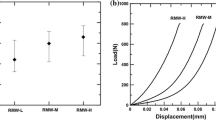The effect of transfer layer formation on friction performance was studied using a brake friction material containing 15 ingredients. Based on a base formulation, 13 friction material specimens containing different relative amounts of ingredients were produced and they were tested on gray iron disks using a small-scale friction tester. A non-destructive four-point probe technique to measure electrical resistance of the thin film was used to estimate the transfer layer thickness. Results showed that the transfer layer formation was highly dependent on the relative amount of ingredients in the friction material and temperature. Among various ingredients, solid lubricants and iron powders increased the transfer layer thickness but no apparent correlation between transfer layer thickness and the coefficient of friction was found. Strong influence from individual ingredients was observed, dominating the friction characteristics during sliding. On the other hand, the thick transfer layers on the disk surface tended to reduce the friction material wear and the amplitude of the friction coefficient oscillation during sliding.
Similar content being viewed by others
References
R. Rabinowicz (1995) Friction and Wear of Materials EditionNumber2 Wiley New York
K.L. Johnson (1985) Contact Mechanics Cambridge University Press Cambridge
G.P. Shpenkov, Friction Surface Phenomena (Elsevier, 1995).
M.G. Jacko S.K. Rhee (1992) Kirk-Othmer Encyclopedia of Chemical Technology EditionNumber4 NumberInSeriesVol. 4 Wiley New York
A.E. Anderson, ASM Handbook, Friction Lubrication and Wear Technology, Vol. 18 (ASM International, 1992)
S.K. Rhee, M.G. Jacko and P.H. Tsang, SAE Technical Paper No. 900004 (1990)
M.O.W. Richardson (1971) Wear 17 89 Occurrence Handle10.1016/0043-1648(71)90021-4
M.G. Jacko P.H.S. Tsang S.K. Rhee (1989) Wear 133 23 Occurrence Handle10.1016/0043-1648(89)90110-5
A. Wirth D. Eggleston R. Whitaker (1994) Wear 179 75 Occurrence Handle10.1016/0043-1648(94)90222-4
P. Filip Z. Weiss D. Rafaja (2002) Wear 252 189 Occurrence Handle10.1016/S0043-1648(01)00873-0
W. Österle I. Urban (2004) Wear 257 215 Occurrence Handle10.1016/j.wear.2003.12.017
V.K. Jain and S. Bahadur, Proc. Int. Conf. On Wear of Materials, ASME (1997) 144–152
V.A. Smurugov (1998) Sov. Friction Wear J. 9 IssueID1 122
M. Eriksson F. Bergman S. Jacobson (1999) Wear 232 163 Occurrence Handle10.1016/S0043-1648(99)00141-6
M. Eriksson S. Jacobson (2000) Tribol. Int. 33 817 Occurrence Handle10.1016/S0301-679X(00)00127-4
W. Österle M. Griepentrog T. Gross I. Urban (2001) Wear 251 1469 Occurrence Handle10.1016/S0043-1648(01)00785-2
G.W. Stachowiak A.W. Batchelor (2001) Engineering Tribology Butterworth-Heinemann Boston
L. Gudmand-Høyer A. Bach G.T. Nielsen P. Morgen (1999) Wear 232 168 Occurrence Handle10.1016/S0043-1648(99)00142-8
G. Nicholson, Facts about Friction (Gedoran America, Winchester, 1995)
W. Gee M. Green (1971) J. Phys. E: Sci. Instrum. 4 70 Occurrence Handle10.1088/0022-3735/4/1/026
M.G. Jacko (1978) Wear 46 163 Occurrence Handle10.1016/0043-1648(78)90118-7
M.H. Cho, J.J. Lee, S.J. Kim and H. Jang, Wear (2005), in print
S.J. Kim H. Jang (2000) Tribol. Int. 33 477 Occurrence Handle10.1016/S0301-679X(00)00087-6
J.K. Lancaster (1985) J. Tribol. 107 437
G.C. Pratt (1967) IMechE 16 132
A. Knop W. Scheib (1979) Chemistry and Application of Phenolic Resins, Ch. 8 Springer-Verlag Berlin
Author information
Authors and Affiliations
Corresponding author
Rights and permissions
About this article
Cite this article
Cho, M.H., Cho, K.H., Kim, S.J. et al. The Role of Transfer Layers on Friction Characteristics in the Sliding Interface between Friction Materials against Gray Iron Brake Disks. Tribol Lett 20, 101–108 (2005). https://doi.org/10.1007/s11249-005-8299-6
Received:
Accepted:
Issue Date:
DOI: https://doi.org/10.1007/s11249-005-8299-6




